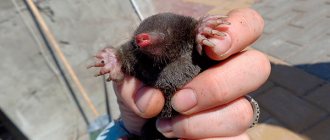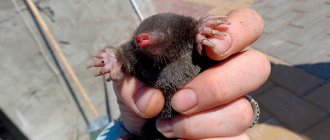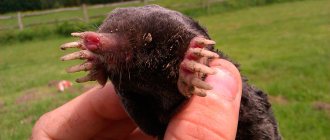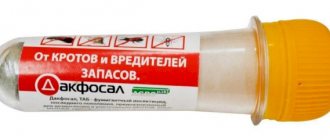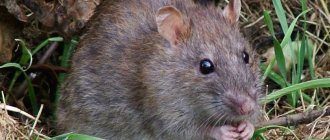The mole is a small mammal covered with fur, unable to see, but perfectly hearing all the vibrations of the earth. Thanks to this, the animal moves well in the dark. It lives and feeds underground, digging huge corridors in which it feeds on earthworms, insects, snails, frogs, and small rodents.
We don't like the mole. And no wonder - in one night it can destroy smooth green grass, undermines the roots of plants, and creates mounds on the surface. How to get rid of moles on your property, folk remedies, poisons and other control methods are described in this article.
You need to know the enemy by sight
Before you start a fight, you need to prepare properly - learn about the strategy and habits of the enemy, which will become a valuable guide to action.
The mole has several features:
- a small rodent with a body length of up to 20 centimeters, black, velvety fur and a rather pleasant appearance;
- at a depth of about 20-50 centimeters below the surface of the earth, the animal digs a system of corridors with a diameter of 6 centimeters and a length of up to 200 meters;
- on the surface the animal creates slides of earth, pushed out of the corridors; the mounds reach a height of several tens of centimeters;
- the rodent patrols the passages every few hours;
- feeds on earthworms, insect larvae, detected thanks to extremely sensitive hearing;
- although it does not feed on plant roots, it can greatly damage them with its activities;
- lives alone;
- is highly active in the morning;
- prefers damp areas, feels great on lawns and beds;
- appears in gardens from early spring to late autumn.
It is worth remembering important features; they are decisive in choosing the method and method of fighting moles in a summer cottage on your own.
A good tip: If mole mounds appear on your property or lawn, use the soil from the mounds to plant potted plants. This land is very fertile.
Burrow length
People, considering the performance achieved by this small builder, focus on the depth of the structure. But there is a more interesting factor that may capture the imagination. Agree, many people can bury themselves four meters into the ground in a straight line. But building tunnels whose length is many times greater than your size is a huge job.
So, this figure can reach up to three hundred and sixty meters (for a mole rat). And it is still unknown whether this is a record. The fact is that many species of moles have not been thoroughly studied. Science knows only general information about them. No one measured the length and depth of their holes. These include, for example, shrews.
Preventive measures
It is better to prevent an underground inhabitant from settling in the countryside than to fight and save the plantings. Let's start with preventative methods.
Horizontal grids
A special mesh is placed under the lawn at a depth of 10 cm (so as not to damage the aerator holes of the mesh with garden tools). Cover the top of the mesh with soil and sow grass. The mesh creates an insurmountable barrier for the rodent.
This mesh can be used throughout the garden (lawn) for protection.
There is only one problem: this method is only suitable for a newly laid garden or lawn, where it is possible to form the surface and remove the soil. It's hard to imagine using it in an existing garden.
Vertical grid
You can also place a grid around the perimeter of the site like a deep (up to 60 cm) foundation.
Such a barrier around the perimeter of the site will make it highly likely that shrews will not get into the garden.
Stone strip
A stone ribbon around the site can give a similar effect as a deep foundation. The ditch is located along the fence at a depth of more than 60 centimeters, about 30-40 cm wide, and is filled with stone debris and broken stones. Theoretically, this will be an insurmountable obstacle for the pest.
Nutritional Features
Field rats prefer grain, cereals, flour, seeds, root vegetables, and juicy grass. It also feeds on small insects, fish, frogs, and mollusks. The land rat swims well, dives well, and is capable of foraging underwater.
The lack of food in the wild forces the animals to move to fields with grain crops. Rats dig holes in the ground, disrupting plant growth. With a large number of rodents in the field, it is impossible to harvest the crop using machinery. The spikelets fall, crumble, and get tangled.
The damage caused by the earth rat is irreparable for gardeners, gardeners, and farmers. A large colony of animals can destroy the entire crop. Animals are forced to sharpen their front teeth on hard surfaces to prevent their growth. They often gnaw tree bark. An attack by a large number of pasyuki is dangerous for poultry and animals.
Chemical methods
These are not just ordinary poisons. Their role is to deter the enemy, they help drive the mole out of the area.
Carbide
The most popular drug poured into a hole is carbide. The mole's passages are filled with water, this causes a reaction leading to an unpleasant odor that scares away the animal.
Attention! Be careful, the acetylene released is explosive!
In large quantities, carbide is harmful to plants.
Lawn granules and fertilizers
These are special substances, biodegradable and environmentally friendly, dispersed in the garden. They emit odors that moles, and even dogs and cats, cannot tolerate. Because of this, they simply avoid these places.
Another form of granules are special fertilizers that, in addition to lawn nutrients, contain special aromas that repel moles. The most popular fertilizers are with the aroma of lavender; they will protect against moles and fill the area with a pleasant aroma.
Smoke candles
Candles are set on fire and placed in the passages. The smoke fills the burrows, then, when exposed to moisture, produces a lethal rodent-killing agent. There are also candles that are less harsh, aimed only at driving out moles.
Purpose
A mole spends its entire life in a hole. Horizontal and vertical labyrinths are located at different depths. The tunnels intersect with each other and have many exits and entrances. Nora looks confused.
The depth of a mole's hole reaches 2 m. How wide the tunnels are can be judged by the number of tubercles above the ground.
- Tunnels for searching for food are placed approximately 15 cm below the soil surface. The animal feeds on earthworms, bugs, roots, plant seeds, root vegetables, and grain.
- The bedroom is located at a distance of 50 cm from the ground surface. It is small in size, covered with straw, grass, and various twigs. By winter, the animal moves to a room that is located at a depth of at least 1 m.
- Deepest of all are the storerooms where the mole stores supplies. Despite its small size, the animal has a brutal appetite. During the day, he eats an amount of food equal to his total weight.
The photo of the mole hole is located below, where you can see numerous tunnels, passages, exits, storage rooms and sleeping places. The mink protects from attacks by enemies, unfavorable external conditions, and ensures normal life functions of the animal.
Mole hole underground
Mechanical means against moles
Listed below are mechanical methods that help fight moles in the garden by repelling them.
Tube-shaped mole traps
Special traps have an elongated shape, the entrances are located on both sides, and the latches effectively block the animal passing through them.
Catch a mole in the garden, as experience shows, is not difficult. Traps are placed in burrows. You need to check their contents every day.
The installed trap must be covered from above. Moles really don’t like open corridors - they simply abandon them. You can cover the exit with the trap with a flower pot. Plastic flower pots are very cheap and weather resistant. Their plastic does not deteriorate over time under the influence of frost and ultraviolet radiation. Soil or sand is poured into the pot, and a brick is placed so that the wind does not overturn it.
A mole, deprived of food, dies after 10 hours, so moving quickly along its corridors, the animal will quickly fall into a trap. A caught mole can be released away from housing, for example, in the forest.
Attention! The mole is a predator; its mouth contains 44 very sharp teeth. Care must be taken when catching an animal or removing it from a trap.
Ejector – sound mole repeller
Electroacoustic devices emit sounds that are inaudible to humans and unpleasant to rodents, with a constant or variable frequency (the latter are more effective because the animal can get used to the sound). Ejector repellers are placed in mole tunnels or inserted into an embankment.
Some devices are also a source of vibration, which scares away animals from their summer cottage. The repeller works thanks to batteries - traditional or solar.
Windmills made from bottles
Windmills, located on pegs buried in the ground, emit sounds and vibrate in the wind, transmitting vibrations to the ground.
Empty bottles buried in the ground so that the wind whistles in the upward-pointing necks work successfully. Periodically, the bottles are moved to another place, because the mole can get used to them.
Firecrackers
Special devices filled with fireworks that are installed in an embankment. The mole, touching them, turns on the detector, which launches fireworks. The mole has no chance.
Reproduction
In Belarus, the mating period for moles begins shortly after the snow melts. In the western and southern regions, pregnant females begin to be seen from April 17, and in the northern regions - from May 5-8. Early and cold spring delays this period, which entails a prolongation of the mating period, birth dates, feeding of the young and their settlement. This leads to the prey of a large number of pregnant and lactating females, and consequently to an overall reduction in the mole population.
The duration of pregnancy in females is 35–40 days. The largest number of pregnant females occurs in May. Most females give birth to 6 cubs. On average, there are about 5 cubs per female.
Females usually have one litter per year. However, on the territory of Belarus, especially in the western and southern regions, it was found that 20–25% of females bear litters twice. The second, summer, offspring occurs from the end of June to the end of July. Signs of a female that has given birth to a second offspring are well-developed mammary glands, nipples (4 pairs of them), around which the hair is wiped. In summer, female fertility is lower than in spring: there are about 4 cubs per female.
Feeding the young continues for about a month. At this time, females often fall into traps. Young moles live peacefully among themselves, but as they mature they become pugnacious. At the age of two months, in the middle or end of June, young moles, the size of which does not exceed 3/4 of an adult animal, begin to be caught in traps. They already lead an independent lifestyle. From the end of June - beginning of July, their mass resettlement begins, which ends by the end of August.
In the first days of settlement, young moles run along the tunnels several at a time. Often young moles can be found on the surface of the earth, where they crawl out through holes in passages or molehills. Sometimes it is possible to catch with one mole trap during the summer, in a course in which all the moles go in one direction, up to 50 or more specimens, of which young animals account for up to 75%.
Moles spread very quickly, as they run along ready-made passages at a fairly high speed—up to 6 m per minute. Research by scientists shows that young moles cover a distance of up to 700 m in 20.5 hours, and adults cover 50 m in 20 minutes. Young moles are more prone to movement than adult moles; the latter do not go further than 400 m in 11 months.
We suggest you read: Mealybug - how to fight it on indoor plants
Material prepared by: horticulture specialist Buinovsky O.I.
The moles' rut begins with the period of snow thawing. The mating period for moles begins in early spring (March-April). Before the onset of mating season, males expand their burrows in search of females. Their genitals are significantly enlarged.
Pregnancy in a female lasts about 40 days. The cubs are born helpless, naked and blind, weighing only 2-3g. As a rule, females give birth once a year, 4-6 cubs are born. The mother constantly guards the offspring, with the exception of the time when she is getting food. At the age of 1 month, the offspring reaches the size of an adult mole. As the cubs grow older, they become pugnacious and do not get along well with their fellows.
After reaching the age of 1-1.5 months, the young leave the nest and begin searching for their own site. During this period, young animals are most vulnerable to predators.
A mole lives on average 3-5 years.
Natural methods on how to remove a mole from the garden
If you are not satisfied with chemical and mechanical methods, there are still natural or simple methods that help fight moles in your summer cottage.
Plants that repel moles
Some plants planted in the garden repel moles with their aroma and secreted substances. Effective herbal remedies for moles:
- basil;
- marigold;
- garlic;
- black elderberry;
- thuja
Grated cloves of garlic (or cloth soaked in its juice) are placed in mole holes. You can pour humus from black elderberry leaves, garlic or thuja branches into the passages.
Natural barriers - oils
Preparations containing natural oils will repel moles from the garden if used regularly in accordance with the instructions on the package. Oils are sold in the form of concentrates; you need to make aqueous solutions and spray them on the area in your garden plot that is susceptible to mole attacks.
How to start protection on time and make it effective
The more you put off the work of protecting your site from moles, the more time you will lose, so you should not evoke the image of a cute, good-natured animal in your mind. Get started as soon as you see the first signs of activity. Otherwise, a network of holes and tunnels will entangle the entire garden, and nothing useful will remain from your plantings.
Protection measures must be continued constantly, even if it seems to you that the moles are completely destroyed, because new moves do not appear. It is quite possible that the animal is temporarily hunting somewhere nearby, and will eventually return to its habitable place. You will have to start all over again.
Moles tend to return to an established place
Please note: moles live in families, that is, a male, a female and their children. Because of this, a whole city with several nests and a huge number of passages will soon form under your site. The wider and deeper this network, the harder it is to smoke out its inhabitants.
Moles have been fought for centuries, and there are many remedies that will help you get rid of these annoying animals. Among them are both folk and modern. The methods of influence are also different, from expulsion from the territory to destruction. What exactly to choose depends on your preferences and capabilities.
Traditional methods
These methods are a collection of folk wisdom collected from various gardeners and industry forums. Some methods are quite aggressive and are not recommended for people with weak nerves.
- Hair. As it turned out, the mole does not like the smell of human hair. Some gardeners roll up the hair collected after cutting and stuff it into holes.
- Animal fur. The hair of cats and dogs gives a similar effect. If there is fur left after grooming your pet, you should not throw it away; it will be useful as a means to get rid of moles in the garden. The wool is laid out in holes.
- Fish remains - according to reviews, the animal hates the smell of herring. This method was shared by a successful gardener. He buried a piece of raw herring every 1.5 m, and since then the pest has disappeared from the site.
- Kerosene. Some summer residents claim that rags soaked in kerosene placed near burrows effectively repel the pest.
- Animal feces. Moles are especially intolerant of cat feces. In this unexpected way, pets will help fight the pest. It is worth collecting feces and placing them directly in the holes.
- An interesting method for removing a mole from a hole from advanced summer residents is to release carbon monoxide into the hole, obtained from the exhaust pipe of a car or tractor.
- Pouring holes, or flood. Place a garden hose in the hole and let water run for an hour. The mole must jump out into one of the exits, the other exits must be covered. You should place a trap near the exit.
- Vinegar. An effective remedy is vinegar. Dilute the vinegar in a large watering can and pour it into the hole. Over the next few days, repeat pouring the solution into adjacent mounds. Animals do not like the pungent smell of vinegar.
Appearance of the animal
The weight of the European mole is 72-128 g, the body length is 113-159 mm, and the tail is 25-40 mm. Males are larger in size than females. The body of the mole is elongated and cylindrical, covered with thick velvety black fur. The mole's fur grows upward, not backward, which allows the animal to freely move through the underground labyrinth in any direction. The fur color is predominantly matte black, but individuals with an ash or brown tint can be found.
Constant movement through tight tunnels causes the fur to quickly dry out, so moles often molt - 3 or 4 times a year. Most animals shed 1-2 times a year. Moles have the best fur after a complete autumn molt - from the end of October. Overwintered moles change their winter fur one by one: first the females molt, and then the males switch to lower spring fur.
The time of spring molting is from April to June. Moles wear spring fur that lasts until mid-July, then summer molting begins in adult moles. Young moles molt for the first time in late July - early August. Summer molting smoothly transitions into autumn, almost without interruption, so that throughout the warm season, moles molt.
Since the mole lives underground, its eyes are practically not developed. They are very small in size or may be absent altogether. There are also no external ears. The mole's nose is a small movable proboscis that protrudes slightly beyond the front incisors. The hair of a mole's tail is capable of performing a tactile function, thanks to which the mole can move backwards along its moves.
The forelimbs of the mole are well developed. They are curved with their palms outward to make it easier for the mole to dig and have 5 strong claws. The mole uses them as a shovel to dig the ground.
The mole also has a well-developed anterior shoulder girdle, so the animal makes passages in the ground quite quickly.
Its cylindrical, shortened, dense body helps it move through dug tunnels. It is slightly pointed at the front and rounded at the back.
The front part is much better developed. The animal has 6 main species and 11 different varieties. They differ in the structure of the jaw, skeleton, their weight, and size.
Young individuals differ from older mammals in the silvery hue of their skin. The mole has practically no neck. The head seems pulled into the shoulders.
The body smoothly touches the triangular head. On the head there is a proboscis, along the edges of which there are vibrissae. Thanks to these sensitive hairs, the animal finds food.
The mole's forelimbs are wide, everted, and shaped like a shovel. Initially the paws are silver-black. Over time they begin to fade.
There are 5 tightly pressed toes on the feet. They are connected by thin membranes. The claws are elongated, strong, slightly flattened. They reach 10 mm in length.
The hind feet are unwebbed, but with very sharp, elongated claws. The animal has 44 teeth, 2 of which are well-developed upper canines. In adult moles, the fangs are severely worn out.
The size of a male mole from proboscis to tail can reach 115-200 mm, females - from 105 to 145 mm. The weight of males is 90-100 g, females - 60-80 g.
How to get rid of a mole in your dacha forever?
Now let's look at more drastic methods of how to remove the pest from a summer cottage.
Poison bait for moles
Poisonous baits (mostly in the form of granules or powder) are very tasty for moles. Poison baits are placed in underground corridors to lure animals.
Traps, mole traps
There are several models of mole traps designed to catch moles, rats, and voles. A hole is opened at a distance of 20 cm and a trap is set. Placement of the trap should be done carefully so that the channel is clean and not contaminated. The clamp is secured with a fixing plate. The trap is covered with turf. Place an opaque bucket upside down on top. The edges of the bucket are sprinkled with soil.
Attention! All operations must be performed with gloves so that the animal does not smell human odor.
Smoke
You can also blow sulfuric acrid smoke into the tunnels, smoke that releases repellent or poisonous gas. For smoke to be effective, it must be used simultaneously in all inhabited burrows. These drugs also work on voles and other rodents.
The mixtures are prepared on the basis of potassium nitrate mixed with powdered sugar. The more sugar, the more smoke.
Be careful! Such mixtures burn intensely, spark, and burning pieces of the composition can fly off, causing burns. Take care of your eyes and skin; you need to set fire to the mixture from a distance.
There are many methods and ideas on how to get rid of moles in the garden. Different methods will be useful in different conditions. The Mole is not an easy opponent and stubbornly returns to its tunnels. When fighting it, you need to remain patient and repeat the procedures regularly. It is better to act differently and try different methods to get rid of the underground tenant of the vegetable garden and garden.
When choosing a method, you should take into account the safety of the inhabitants of the dacha, including pets. Some types of poisons can be eaten by chickens, cats and other pets. Particular attention should be paid to the possibility of children having access to poisons, explosives, traps and snares.
At what depth do they live?
Still, let's figure out at what depth moles live. The depth of habitat at any time of the year remains almost unchanged - up to 50 cm. It makes no sense for the animal to dig deeper passages because it costs too much energy. After all, at great depths they are no longer able to raise the ceiling of the passage; they have to push the dug up soil with their hind legs to the surface. And the deeper you have to dig, the more problematic it becomes to carry out this titanic work. A deep hole occurs only in one case - when moles arrange a nesting chamber for sleep and rest.
In winter, the mole eats less than in summer, and sinks deep into the soil following the worms. For the winter it makes food reserves, which, as a rule, consist of earthworms. The animal bites off the heads of invertebrates, thereby paralyzing them. Worm reserves can be located along the entire length of the tunnels or hidden in a special chamber. Sometimes in the burrows and passages of an animal you can find up to five thousand invertebrates prepared in this way.
In a cold, snowless winter, when the soil freezes to a depth of more than 50 cm, animals die from lack of food.
At the same time, thanks to their warm fur, moles are not at all afraid of frost. They can get out even in winter, but they still prefer to stay under the snow and crawl out from under it infrequently. The main enemy of the animal in winter is precisely hunger.
Adults prefer a solitary lifestyle. They protect their territory from their own kind and can bite to death.
Cannibalism is even common among moles. At the same time, many predatory animals do not eat animals because of their specific musky smell.
The mole comes to the surface very rarely - due to the structural features of the front legs, which are adapted for digging, the animal does not walk, but crawls.
Mole tunnels often attract other animals. For example, shrews climb into them and eat all the worms. And in winter, the passages are used by rodents of the mouse and hamster families.
Many people only know about the small animals living in the village from cartoons. We are talking about moles. Not many have seen them in the natural environment. And when they noticed it and examined it, they got scared. Their forelimbs look so bright. And, of course, not every person can tell how deep a mole’s hole is. For non-specialists, this interesting topic often remains a “closed secret.” But in fact it is quite educational. Not only biologists, but also people of other specialties study this topic in detail, keeping in mind its practical application. Let's not lag behind either. It might come in handy!
Read also End of October nature photos
